Facts About Grand Teton National Park
Includes Fun Facts, History, Geology, Geography and more.
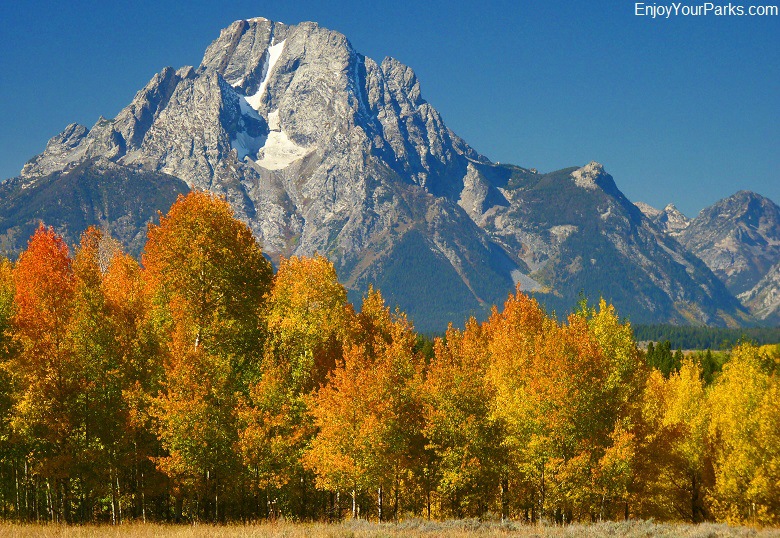
Mount Moran, Grand Teton National Park
Grand Teton National Park is one of the most scenic national parks in the world, with the magnificent Teton Range being the center of attention. Rising nearly 7,000 vertical feet above the Jackson Hole Valley to the East, there are virtually no obstructions as you see these incredibly jagged mountains reach for the heavens. Being the youngest mountain range in the Rocky Mountains, very little erosion has taken place, which allows for such an amazing landscape.
Being 310,000 acres in size, Grand Teton National Park is not as large as Yellowstone Park or Glacier Park, but every square inch of this amazing national park is visually stunning and well worth the effort to explore. The highest peak in the Teton Mountain Range is Grand Teton at 13,770 feet above sea level, and many other peaks in this range are over 12,000 feet in height. The adjacent Jackson Hole Valley that is nestled right next to these towering giants has an average elevation of 6,800 feet. This elevation difference allows for a breathtaking landscape that is unquestionably among some of the most scenic spectacles on planet earth.
The famous Snake River meandors along the valley floor, thus making this special place even more stunningly gorgeous...not to mention the crystal clear lakes found along the base of these great mountains. No matter how many times we've been to Grand Teton National Park, these incredible mountains that seem to literally touch the sky never fail to take our breath away.
Below are some fun facts about Grand Teton National Park, as well as some brief history on how Grand Teton Park came to be. This page also touches on some of the interesting geology that has (and is presently occurring) in the Teton area, and also some fascinating information about the glaciation that has made its presence known in Grand Teton National Park through the ages.
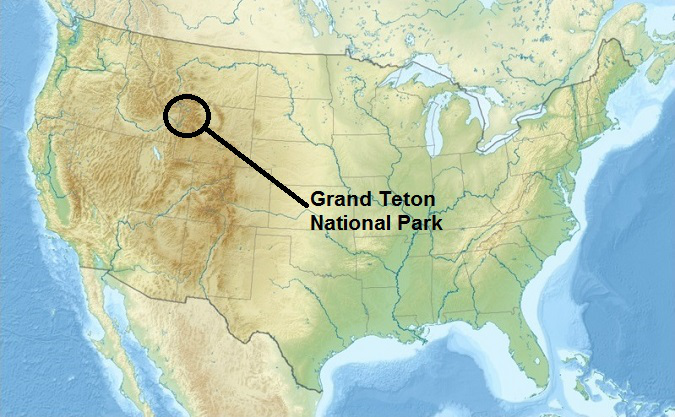
Courtesy of USA edcp relief location map.png.
FUN FACTS ABOUT GRAND TETON NATIONAL PARK
Portions of this section courtesy of NPS.
GRAND TETON NATIONAL PARK LAND
Total size: 310,000 acres (485 square miles)
Dimensions: 45 miles long x 26 miles wide
Highest Point: Grand Teton (13,770 feet)
Lowest Point: Fish Creek (6,320 feet)
GRAND TETON PARK CLIMATE
Annual Average Precipitation: 21.6 inches
Average Snowfall: 173 inches in valley, 450 inches in mountains
Extreme High Temperature: +97 degrees Fahrenheit
Extreme Low Temperature; -63 degrees Fahrenheit
GRAND TETON NATIONAL PARK HISTORIC DATES:
Originally Founded: February 26, 1929
Jackson Hole National Monument: 1943
Original Grand Teton Park and Jackson Hole Nat'l Monument Combined: 1950
John D. Rockefeller, Jr. Memorial Parkway (23,700 acres): 1972
GRAND TETON PARK WILDLIFE
17 species of carnivores (including grizzly bears and wolves)
22 species of rodents
6 species of hoofed animals
4 species of reptiles
6 species of amphibians
3 species of rabbits/hares
6 species of bats
16 species of fish
300+ species of birds
900+ species of flowering plants
7 species of conifer trees
GRAND TETON PARK ENTRANCES
Number of Park Entrances: 4
Moose Entrance (South Entrance on Teton Park Road)
Granite Canyon Entrance (on Moose Wilson Road)
Moran Junction (Highway 89, Northeast Entrance)
Note: The "North Entrance" to Grand Teton Park is usually considered to be at the South Entrance of Yellowstone National Park, as it marks the beginning of the Rockefeller Parkway heading into Grand Teton Park.
GRAND TETON PARK ROADS
Miles of paved roads: 152 miles
Miles of unpaved roads: 65 miles
GRAND TETON HIKING TRAILS
Miles of hiking trails: 242 miles
TETON MOUNTAIN RANGE
Active Fault Block Mountain Range
Youngest Mountain Range in the Rockies
40 miles long x 8 miles wide
Highest Peak: Grand Teton (13,770 feet)
Number of peaks over 12,000 feet: 8
GRAND TETON PARK LAKES
Largest lake: Jackson Lake (25,540 acres, 15 miles x 5 miles)
Maximum depth of Jackson Lake: 438 feet
Number of moraine lakes: 7
(Include Jackson Lake, Leigh Lake, String Lake, Jenny Lake, Bradley Lake, Taggart Lake, Phelps Lake)
Number of alpine lakes: 100+
GRAND TETON PARK'S SNAKE RIVER
The Snake River is the largest river in Grand Teton Park.
The Snake River Is the headwater of the Columbia River System.
Major Tributaries of the Snake River: Pacific Creek, Buffalo Fork, Gros Ventre River
GRAND TETON PARK CAMPGROUNDS
Total number of campgrounds: 7
Headwaters Campground & RV Sites
Lizard Creek Campground
Colter Bay Campground
Colter Bay RV Park
Signal Mountain Campground
Jenny Lake Campground (tent only)
Gros Ventre Campground
For details on all the Grand Teton Park Campgrounds, click here.
GRAND TETON PARK LODGES / CABIN RENTALS
Jackson Lake Lodge
Signal Mountain Lodge
Jenny Lake Lodge
Dornans (private)
Triangle X Ranch (private)
American Alpine Club Climbers' Ranch
Colter Bay Cabins
Headwaters Lodge & Cabins at Flagg Ranch
For details on all the Grand Teton Park lodges, hotels and cabins, click here.
GRAND TETON PARK VISITOR CENTERS / MUSEUMS
Number of Visitor Centers: 5
Craig Thomas Discovery and Visitor Center (located near Moose Junction, south section of park)
Colter Bay Visitor Center & Indian Arts Museum (Colter Bay Village, north end of park)
Jenny Lake Visitor Center
Flagg Ranch Visitor Center
Laurance S. Rockefeller Preserve Center
BRIEF HISTORY OF GRAND TETON NATIONAL PARK
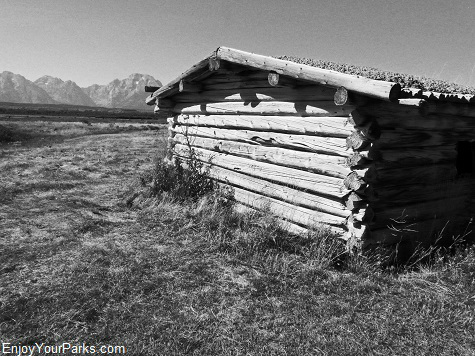 Grand Teton National Park received its name from early 19th century French trappers who called the Teton Mountain Range "les trois tetons", which means "the three breasts" or "the three teats". The peaks. they were referring to were Grand Teton, Middle Teton and South Teton, which definitely stand out,
Grand Teton National Park received its name from early 19th century French trappers who called the Teton Mountain Range "les trois tetons", which means "the three breasts" or "the three teats". The peaks. they were referring to were Grand Teton, Middle Teton and South Teton, which definitely stand out,
especially when viewing this massive range from the Idaho side (west side). The name was later shortened to "Tetons". More than likely however, the Shoshone Indians many years earlier called the entire mountain range "Teewinot", which means "many pinnacles". But the name "tetons" stuck, and became their official name, whereas the name "Teewinot" became the name of one of the prominent peaks in the range.
Early Inhabitants
Evidence suggests that the Grand Teton Area was first inhabited by Native Americans around 11,000 years ago, but only by migratory hunters and gatherers. The weather and temperature was very harsh at that time, and these early people left the area during the colder months exactly as the Teton elk herd still does to this day. In fact, they followed the elks' precise migratory path. And from 11,000 years ago to about 500 years ago, nothing changed with this migratory pattern, and no permanent settlement existed.
First White Explorers
The first white explorers entered the seen in the early 1800's, when a member of the Lewis and Clark Expedition named John Colter left the expedition on its way back to St. Louis (with Lewis & Clark's
permission), and joined up with 2 trappers to explore the area to the south of their Montana expedition, which happened to be Yellowstone Park and Grand Teton Park. In 1807 and 1808, John Colter entered what is now known as Jackson Hole, and became the first caucasian to see the Teton Range.
In 1810, John Colter again met up with William Clark in St. Louis to produce a map of this area, and then for the next 30 years, John Colter- known as "the first mountain man", visited Jackson Hole on a regular basis to trap beaver for their lucrative pelts.
Fur Trading
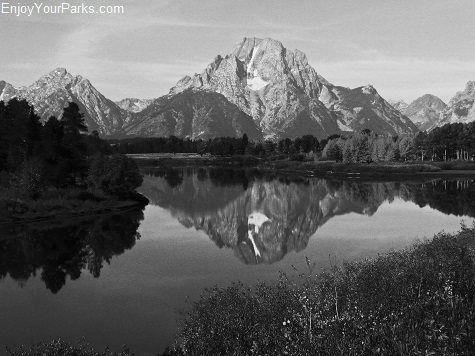 The period between 1810 and 1820 marked a period of some serious competition from various fur trading companies for the plentiful beaver population and their valuable pelts, but in the early 1820's the Rocky Mountain Fur Company began to dominate the seen. Three members of this company included Jedediah Smith, William Sublette, and David Edward Jackson (known as Davey Jackson).
The period between 1810 and 1820 marked a period of some serious competition from various fur trading companies for the plentiful beaver population and their valuable pelts, but in the early 1820's the Rocky Mountain Fur Company began to dominate the seen. Three members of this company included Jedediah Smith, William Sublette, and David Edward Jackson (known as Davey Jackson).
Jackson had the job of overseeing the trapping operations in the Teton Area from 1826 to 1830, and the area became known as Jackson's Hole. Later the name was shortened to Jackson Hole, and this valley has been called this ever since.
Once most of the beavers were trapped and the beaver population dropped dramatically, white trappers left the area, and between 1840 and 1860 only a handful of small Native American tribes remained.
Organized Expeditions
The first U.S. Government sponsored expedition in 1859-1860, known as the Raynolds Expedition, was led by Captain William F. Raynolds. Captain Raynolds was guided by a well-known mountain man by the name of Jim Bridger, and among this team of adventurers was a famous naturalist by the name of F.V. Hayden. Their assignment was to leave the Teton area and cross over a pass that would lead them into the Yellowstone Area, but the party was stopped by horrible weather conditions and deep snow fall. They otherwise would have become the first organized expedition to see Yellowstone National Park.
The Civil War temporarily stopped all exploration efforts into the Yellowstone - Teton area, but once the war ended, F.V. Hayden led the Hayden Geological Survey of 1871 into this area. In 1872, a small group of men led by James Stevenson was ordered to branch off from the main party and was to explore the Teton area. A photographer by the name of William Henry Jackson was in this party of explorers, and took the very first-ever photo of the Tetons. During this expedition, many of the lakes and mountains were named.
Ranching
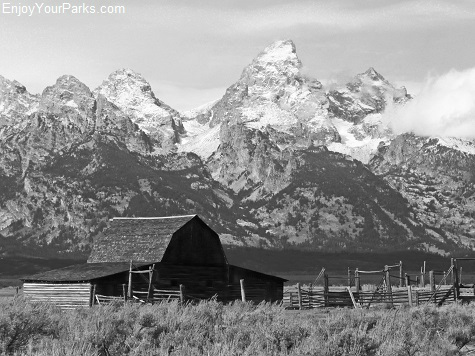 After that, several adventurers attempted to mine the area for gold and silver with little success, and pioneers began to also arrive in the hopes of farming or ranching. In time, cattle ranching prevailed and by 1890, there was a permanent population of 60 people. In 1892 near present day Moose, Menor's Ferry
After that, several adventurers attempted to mine the area for gold and silver with little success, and pioneers began to also arrive in the hopes of farming or ranching. In time, cattle ranching prevailed and by 1890, there was a permanent population of 60 people. In 1892 near present day Moose, Menor's Ferry
provided a way for wagons to cross the Snake River onto the west side of the mighty Snake, where ranching further began to flourish up to the early 1920s.
There was then a dramatic economic down turn which decreased the ranching operations in the area.
However, as the automobile became more and more popular, many of these ranches became what is known as "Dude Ranches". These Dude Ranches showed visitors from the city what life was like on a real western cattle ranch, thus was born a new revenue source in the Jackson Hole area, and has remained extremely popular ever since.
Establishment of Grand Teton National Park
Not long after Yellowstone National Park was established in 1872, there was talk of expanding Yellowstone Park to at least included the central Teton Range and the 7 moraine lakes at the base of these mountains. Through these discussions and debates, the majority concluded that it would be best to create an additional national park. Therefore, on February 26, 1929, President Calvin Coolidge signed the executive order that established the Teton Range and lakes a national park. Thus Grand Teton National Park was born.
John D. Rockefeller, Jr.
The original park was only 96,000 acres in size, and most of the Jackson Hole Valley was still privately owned. Then in the 1920's, John D. Rockefeller Jr. and his family visited the area, and he immediately realized that the land surrounding the Tetons needed to be protected just as much as the Teton Range itself. So he quietly began to buy up much of the land in the Jackson Hole Valley that was adjacent to this great mountain range.
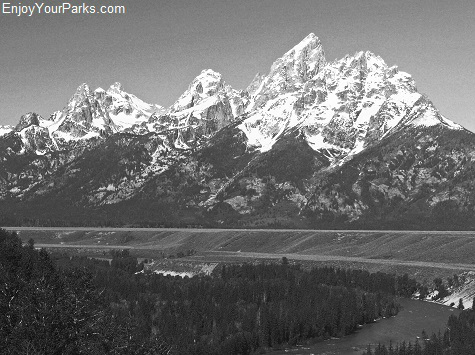 Though highly controversial and not well thought of by many of the local residents, John D. Rockefeller, Jr. handed over his ownership of his newly acquired 221,000 acres of Jackson Hole land to the federal government in 1943 with the agreement that they would protect it.
Though highly controversial and not well thought of by many of the local residents, John D. Rockefeller, Jr. handed over his ownership of his newly acquired 221,000 acres of Jackson Hole land to the federal government in 1943 with the agreement that they would protect it.
Immediately following this transaction, President Franklin Roosevelt then used the Antiquities Act to make this land a national monument, and called it the Jackson Hole National Monument. Finally in 1950, the original Grand Teton National Park of 96,000 acres and the Jackson Hole National Monument of 221,000 acres were officially combined into the present day Grand Teton National Park.
For many years the land between Grand Teton National Park and Yellowstone National Park was protected and yet not defined as an entity. In 1972, this 23,700 acre forested section was officially named The John D. Rockefeller, Jr. Memorial Parkway, forever protecting this land just as if it were itself a national park. This tract of land is part of the Grand Teton National Park's jurisdiction and responsibility.
And to wrap up the history of the establishment of Grand Teton National Park, in 2007 the Rockefeller family, who had owned what is known as the JY Ranch since the 1920's, donated this historic ranch to the park. Located on the southern border of Grand Teton National Park near Phelps Lake, this land and its historic buildings are now part of the Laurance S. Rockefeller Preserve of Grand Teton National Park.
GRAND TETON PARK GEOGRAPHY
Grand Teton National Park is located entirely in the state of Wyoming, and is 310,000 acres in size. To the north lies the John D. Rockefeller, Jr. Parkway, which is a 23,700 tract of land connecting Grand Teton National Park with Yellowstone National Park. Most of the Jackson Hole Valley and all of the major peaks of the Teton Range are located within the park boundary.
Bordering Grand Teton National Park to the west is the Jedediah Smith Wilderness of the Caribou-Targhee National Forest. To the northeast lies the Teton Wilderness and Gros Ventre Wilderness of the Bridger-Teton National Forest. The National Elk Refuge is directly to the south of Grand Teton National Park.
Greater Yellowstone Ecosystem
All of the land mentioned above, as well as the national forest and wilderness land surrounding Yellowstone National Park, all are part of what's known as the Greater Yellowstone Ecosystem. This immense 18 million acre expanse is one of the largest remaining intact mid-latitude ecosystems in the world.
GRAND TETON NATIONAL PARK GEOLOGY
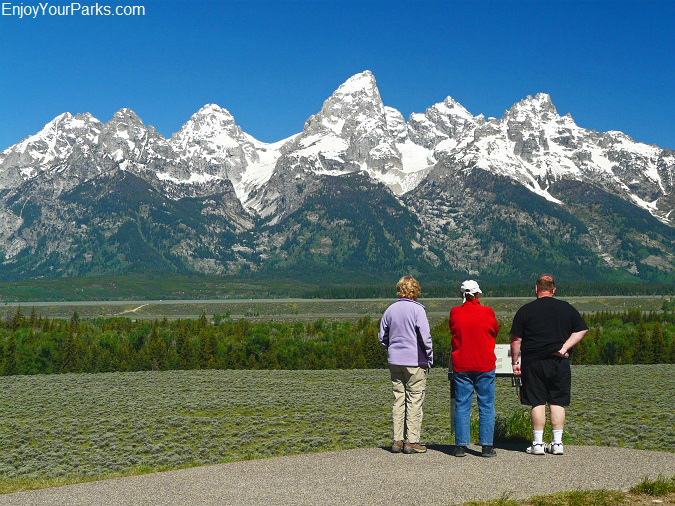
The Teton Range in Grand Teton National Park rises nearly 7,000 vertical feet above the valley floor.
The Teton Range is the youngest mountain range in the Rocky Mountains. Their began to emerge only 6 million years ago through what geologists call fault-block formation. This active fault-block runs north and south for about 40 miles, where the land that makes up the west block is rising upward (The Teton Range), and the east block is lowering (Jackson Hole Valley). And as these geological forces are still at work today, the mountains of the Teton Range are continuing to grow.
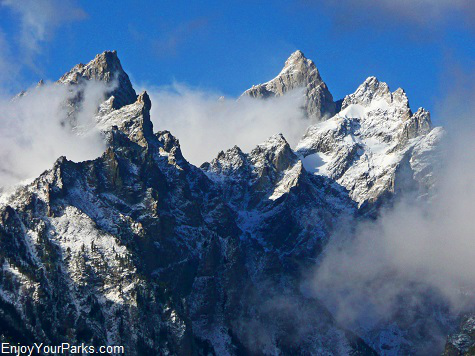 The fault line between these to massive blocks lies just at the base of the Teton Range, and because this geologic action is so young, none of the mountains have eroded enough to create foothills. And because there are absolutely no foothills, the 6 to 7 thousand foot vertical expression of these great mountains can be seen all the way from the Jackson Hole Valley Floor to the tops of the peaks with no obstructions.
The fault line between these to massive blocks lies just at the base of the Teton Range, and because this geologic action is so young, none of the mountains have eroded enough to create foothills. And because there are absolutely no foothills, the 6 to 7 thousand foot vertical expression of these great mountains can be seen all the way from the Jackson Hole Valley Floor to the tops of the peaks with no obstructions.
The eastern block (Jackson Hole Valley) has lowered nearly 30,000 vertical feet since the fault block was activated 6 million years ago! But due to gradual erosion throughout the region, the valley has filled up with sediment, and only 7,700 vertical feet is exposed between the two active blocks.
Some of the oldest rock in the United States are found in Grand Teton National Park. Formed about 2.5 billion years ago, these rocks are metamorphic in nature, and are composed of schist and gneiss. These darker-colored rocks are found in the northern and southern sections of the park, whereas the central Teton Range, which includes the tallest peaks such as Grand Teton, are composed of a light colored granite, which is an igneous rock formed by the slow cooling of molten magma underneath the surface of the earth. On top of this large granite massif were layers of sedimentary rock formed from an ancient sea bed, and there is still evidence of this layer of sedimentary rock on the very top of the flat-shaped summit of Mount Moran.
TETON RANGE GLACIATION

Teton Glacier, Grand Teton National Park.
As the west block rose thousand of feet in elevation, several ice ages beginning about 200,000 years ago began to carve away at the exposed rock. The most recent ice age, which occurred 15,000 years ago known as the Pinedale Glaciation Period, dramatically shaped the landscape to what you see today. Massive glaciers known as "valley glaciers" were thousands of feet thick, and they cut through the rock as gravity moved them downward off the top of this huge block of exposed rock. Sharp peaks, jagged aretes and horns were the result, and large U-shaped valleys were created such as Cascade Canyon as these giant rivers of ice flowed down the canyons.
The lakes found along the base of the Teton Range such as Jackson Lake and Jenny Lake, are a result of moraines (piles of gravel) that were left at the end (foot) of these massive glaciers.
 Alpine Glaciers of Today
Alpine Glaciers of Today
Following the retreat of the glaciers of the Pindale Ice Age that ended about 11,000 years ago, smaller cousins of the massive valley glaciers began to establish themselves approximately 7,000 years ago on the north and northeast slopes of the central Teton Range. These smaller glaciers are known as "alpine glaciers", and are the same type of glaciers found in present day Glacier National Park Montana. These glaciers do not dramatically alter the landscape like the valley glaciers do, but still chew away some of the rock as they slowly slide down the slopes of the mountains due to gravity.
These small alpine glaciers slowly began to retreat, but experienced a growth period during what was known as the Mini Ice Age. The Mini Ice Age occurred between 1400 to 1850 AD, and had a significant impact on the northern countries of Europe, as well as the United States and Canada. However, ever since the end of the Mini Iced Age in the 1850's these small glaciers have been once again shrinking. There are now about a dozen alpine glaciers remaining in the Teton Range of Grand Teton National Park, such as Teton Glacier and Schoolroom Glacier, and someday they will no longer continue to move and cut rock, therefore losing their "glacier" status, just as the alpine glaciers of Glacier National Park.
Where To Go, What To Do, and Where To See Animals in Grand Teton National Park...
For all the details on where to go, what to do, and where to see animals in Grand Teton National Park, please visit our page entitled "All About Grand Teton National Park".



